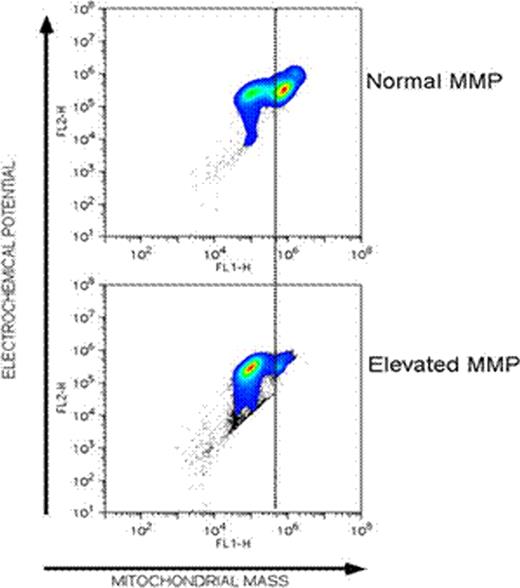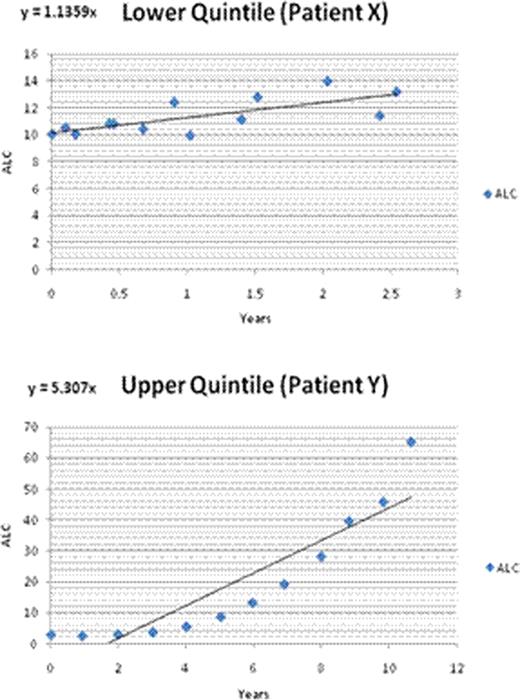Abstract
Abstract 1765
Chronic lymphocytic leukemia (CLL) can be characterized by a variable natural history. While some patients have an aggressive disease course, others have an indolent course and never require treatment. Disease stage at diagnosis, cytogenetic changes, and mutation in the immunoglobulin hypervariable region, among other disease markers, have important prognostic contributions, but these prognostic markers do not reliably identify patients with an indolent natural history. We analyzed 174 individual patients with CLL and found that patients whose CLL cells retained a mitochondrial membrane potential (MMP) as measured by retention of the cyanine dye, JC-1, similar to normal B-lymphocytes had a particularly indolent disease course. While 73% of CLL patients had a substantial population of malignant lymphocytes with a higher mitochondrial membrane potential, 27% of patients had energetically normal CLL cells confirmed by co-immunostaining with anti-CD5 and anti-CD19. Elevated mitochondrial membrane potential is defined by the lymphocyte population having >50% of cells with a relative membrane potential (FL2/FL1=electrochemical potential/mitochondrial mass) > 2.0 (Figure 1).
Patient samples from untreated patients were also organized into quintiles based upon the percentage of cells that populated the low mitochondrial membrane potential gate versus the percentage of cells that populated the high mitochondrial membrane potential gate (Figure 2). Patients in the lower quintile exhibited a predominance of cells in the low membrane potential gate across a broad range (.02%-42%) whereas patients in the upper quintile exhibited a predominance of cells in the high membrane potential gate across a much narrower range (88.6%-96.7%).
With up to six years of follow up, no patient with normal MMP has required treatment or has advanced beyond Rai stage 0. Cytogenetic changes in this subgroup include normal cytogenetics, del13q, del11q, trisomy12, and del6q23. Of the 30 patients where immunoglobulin heavy chain variable gene mutations were measured, no patients with low MMP had a germline configuration. Lymphocyte doubling time was calculated for all patients for whom data is available and it is interesting to note that patients falling within the first quintile exhibited a median slope value of ∼1 with a median lymphocyte doubling time of ∼1.5 years, whereas patients in the upper quintile within the upper quintile exhibited a much steeper median slope value of 23 and an accelerated lymphocyte doubling time of approximately 7 months (see Figure 3 for patient examples).
CLL cells with higher mitochondrial membrane potential have ultrastructural changes in the mitochondria typical of cells primarily utilizing glycolysis, but no difference in mitochondrial mass. CLL cells with a predominantly elevated MMP have increased lactate production and dramatically shortened survival when grown in media containing pyruvate as the primary energy substrate instead of glucose. These results indicate a significant difference in energy utilization and intracellular metabolism between malignant cells with normal and high MMP. Some patients with CLL cells that have elevated MMP appear to have an indolent disease course suggesting that elevated MMP does not necessarily portend an aggressive natural history, but to date, patients with CLL populations characterized by elevated MMP have encompassed the only patients in our study population who have required treatment directed at the CLL. The data indicate that analysis of the MMP in the CLL population can provide important prognostic information and may identify a population of patients with a benign course of disease. The prognostic significance of MMP in patients with CLL is independent of cytogenetics. The finding of low MMP appears to be confined to patients without a germline IGHV configuration. These results also indicate that the metabolic state of the malignant cell may play a central role in the clinical manifestation of disease and may point to the development of novel therapies that target mitochondrial respiration.
Lamanna:Celgene Corporation:. Weiss:Celgene: Membership on an entity's Board of Directors or advisory committees. Scheinberg:Actinium Pharmaceuticals, Inc.: Membership on an entity's Board of Directors or advisory committees, Patents & Royalties, Research Funding.
Author notes
Asterisk with author names denotes non-ASH members.




This feature is available to Subscribers Only
Sign In or Create an Account Close Modal